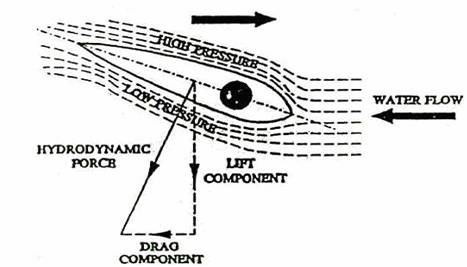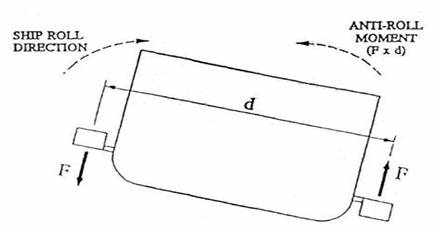Question
Describe the
effect on GM of rolling and how bilge keels, anti rolling tanks and stabilizer
fins reduce the amplitude of rolling.
The natural
rolling period of a ship maybe estimated by the formula:
2πk/√gGM seconds
Rolling period P=† †††††††
where
GM is the metacentric height
k
is the radius of gyration of the loaded ship about a longitudinal polar axis.
Thus a large metacentric height will produce a small period of roll,
although the movement of the ship may be decidedly uncomfortable and possibly
dangerous. A small metacentric height will produce a
long period of roll and smooth movement of the ship.
The simplest form of stabilization, bilge keels, are often fitted even
when other more sophisticated methods of roll reduction are used. Cheap and easy
to maintain, they can provide up to 30% roll amplitude reduction and are
effective when a ship is at rest or making headway.
These stabilizes
use the movement of slack liquid in a tank to produce a moment in opposition to
the rolling, moment. Since the liquid, in the tank, is a separate mass
from the vessel it will possess different inertia. When the vessel rolls,
there will be a time lag before the water begins to-move in the same direction.
If the water movement in the tank can be controlled so that it is
continuously out of phase with the movement of the vessel, then there will be
an anti-roll moment
The tank system to control
the water movement may be one of three types, namely;
Pure
Passive in which the movement of water is controlled by vertical or horizontal
restrictions such as baffle plates or manually operated valves.
Controlled Passive in which
the water movement is controlled by air or water valves
acting in response to a roll sensing device such as a gyro.
Active Controlled in which
the water movement is aided by the addition of an impeller
or pump. Large masses of water need to be moved
continually which requires high power. Initial high cost together
with higher maintenance make this an expensive system.
Control is again related to a roll sensing
device such as a gyro.
Anti-heeling tanks
Container ships and RO-RO
(roll onóroll off) vessels are usually fitted with anti-heel tanks which enable
the ship to be kept upright during uneven loading of cargo. Transfer of liquid
from one tank to the other is by pump or compressed air.
Controlled passive system
stabilizing tanks are used in the anti-heeling arrangements of some ships. The
simplest method in this scheme, for transferring the liquid, makes use of
compressed air admitted to the top of either tank, to force the liquid from one
to the other.
FIN STABILISERS
This system consists of
fixed or retractable fins fitted port and starboard, ideally at the point of
maximum beam and with the fin axes intersecting the round of bilge in line with
the ships rolling centre. 
The fins are aerofoil in
shape, similar to a rudder, and produce a hydrodynamic force when turned to an
angle to the flow of water. As the water flows around each fin, pressure
differences are created, generating a force with an
vertical component (lift) and a longitudinal component (drag). The fins are
fitted port and starboard at about bilge keel level in the midship
region of the ship so that forces generated give a maximum couple to oppose
rolling
† 